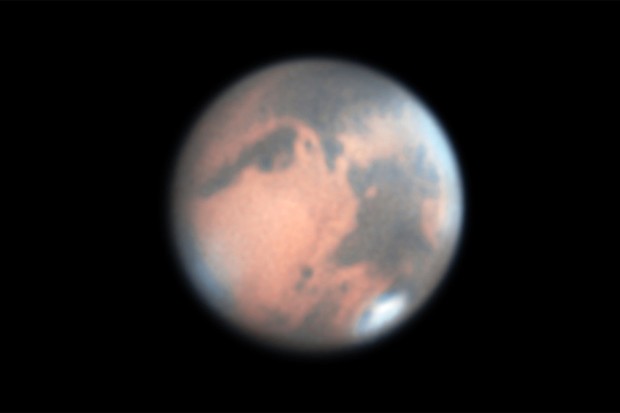[ad_1]
The excitement is increasing as Mars approaches opposition on 8 December. This is because Mars oppositions are a big deal.
The term opposition describes when a planet appears on the other side of the sky to the Sun.
Geometrically, this also means we’re closer to a planet at opposition than at any other time.
For more distant worlds, the difference that makes to its appearance isn’t so significant.

An exception is Saturn, but only because of the ‘opposition effect’, a phenomenon that makes Saturn’s rings glow brighter at opposition than at other times.
However, Mars is a nearer world and its opposition appearance is considerably better than at other times.
When are Mars oppositions?

Mars oppositions occur every 2.1 years. At optimal oppositions it appears to have an apparent diameter over 20 arcseconds across.
As well as appearing to expand in size through the eyepiece, to the naked eye Mars also brightens impressively around opposition.
Less favourable oppositions may present the planet with an apparent arcsecond diameter in the low-teens.
The 2022 Mars opposition has the Red Planet reaching a maximum apparent diameter of 17.2 arcseconds on 1 December, when Mars is closest to Earth. At this time it’ll appear to shine at mag. –1.8.
Photographing Mars at opposition

If you’re wondering what the best way is to image Mars around opposition, the answer depends on what kit you have available.
Smartphone

The planet’s impressive orange-hued, star-like dot should be relatively easy to photograph with a modern smartphone, even if it doesn’t pick up many surrounding stars.
Here, a good strategy is to catch Mars low in the sky, bringing foreground objects into the view to give the planet context.
A bright Moon can be used to set the scene too. Grab a show of the full Moon near bright Mars, low above a visible horizon and you’ll have a winning shot.
Dates when this will happen are 10 and 11 November, and the nights of 7 and 8 December.
Mars is occulted by the Moon early on 8 December, so prepare to extend the evening session on 7 December into the early hours of the following morning for some real Moon–Mars drama.
For more advice, read our guide on how to photograph the night sky with a smartphone.
DSLR camera

A DSLR or equivalent camera with a mid- to wide-angle lens will be able to capture some serious shots of Mars, with or without the Moon.
The planet is currently moving fairly slowly through Taurus, a feature-rich part of the sky.
Mid-angle lenses should capture the planet and most, if not all, of the stars surrounding it.
This includes the beautiful Pleiades and Hyades open clusters, as well as bright Aldebaran (Alpha (α) Tauri) which conveniently, for comparison purposes, also appears orange.
A wide-angle lens could extend the sky coverage to include the Orion constellation too.
A DSLR or equivalent allows you to get a great shot of the general star-scene with Mars, using relatively short exposures on a fixed tripod.
From a dark-sky site, consider using a tracking mount to extend exposure time.
This will allow you to reduce ISO, producing better colour tone and less noise in your images.
It will also allow you to go deeper in terms of the stars and nebulosity that are revealed.
Photograph Mars at opposition: step-by-step
Equipment
- Camera
- Fixed or tracking mount
[ad_2]
